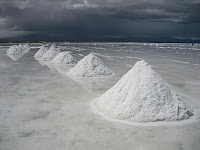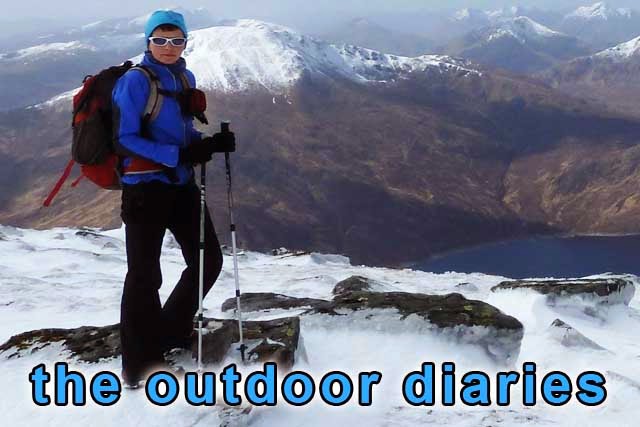Uyuni is a pleasant, small town set at 12,000 feet and rather out on a limb on the Bolivian Altiplano. It has attractive colonial buildings, a handsome town clock and railway-themed artworks, reflecting its past status as a key railway junction. Trains still pass through and late at night I hear their whistles blowing - proper, old-fashioned train whistles and I imagine it must be Casey Jones pulling the cord! Every couple of days, the main street is given over to a lively market which gives the town a carnival atmosphere - there are stalls, bands and hot food. I tried the local speciality and ate llama - not a whole one! On a world map Uyuni is an insignificant, tiny dot but I travelled here for a very special reason ... I came to make a dream come true.
limb on the Bolivian Altiplano. It has attractive colonial buildings, a handsome town clock and railway-themed artworks, reflecting its past status as a key railway junction. Trains still pass through and late at night I hear their whistles blowing - proper, old-fashioned train whistles and I imagine it must be Casey Jones pulling the cord! Every couple of days, the main street is given over to a lively market which gives the town a carnival atmosphere - there are stalls, bands and hot food. I tried the local speciality and ate llama - not a whole one! On a world map Uyuni is an insignificant, tiny dot but I travelled here for a very special reason ... I came to make a dream come true.
 limb on the Bolivian Altiplano. It has attractive colonial buildings, a handsome town clock and railway-themed artworks, reflecting its past status as a key railway junction. Trains still pass through and late at night I hear their whistles blowing - proper, old-fashioned train whistles and I imagine it must be Casey Jones pulling the cord! Every couple of days, the main street is given over to a lively market which gives the town a carnival atmosphere - there are stalls, bands and hot food. I tried the local speciality and ate llama - not a whole one! On a world map Uyuni is an insignificant, tiny dot but I travelled here for a very special reason ... I came to make a dream come true.
limb on the Bolivian Altiplano. It has attractive colonial buildings, a handsome town clock and railway-themed artworks, reflecting its past status as a key railway junction. Trains still pass through and late at night I hear their whistles blowing - proper, old-fashioned train whistles and I imagine it must be Casey Jones pulling the cord! Every couple of days, the main street is given over to a lively market which gives the town a carnival atmosphere - there are stalls, bands and hot food. I tried the local speciality and ate llama - not a whole one! On a world map Uyuni is an insignificant, tiny dot but I travelled here for a very special reason ... I came to make a dream come true.The road across southwest Bolivia is an appalling dirt track that traverses difficult and empty terrain so I´m using the bus to explore this part of the country until I hit tarmac again further north. It´s no trouble taking the bicycle on the bus - it goes up on the roof! For the next month I´ll be living above 12,000 feet. The altitude doesn´t seem to be causing me any problems except having a permanently gunky nose and first thing in the morning, when it´s all dried up, it feels like there´s a bunch of cornflakes up there!
One day´s dusty bus ride from Uyuni took me to Potosi, a World Heritage site and a beautiful old city. At over 13,000 feet, it´s the highest city of its size in the world. The centre is comprised of brightly-painted, grand colonial buildings and some slightly crumbly ones which  are no less charming. Radiating out from the main plaza are narrow streets where policemen in white gloves direct the traffic. The city is dominated, past and present, by the scarred slopes of one mountain- Cerro Rico. Since colonial times, Cerro Rico has yielded vast quantities of silver and at the peak of production, Potosi was one of the wealthiest cities in the world, comparable to London or Paris. Ambling around the city´s attractive streets and plazas today, that wealth is still very much in evidence. But there is a grim reality behind the money - it´s estimated that 8 million people have died in the silver mines of Cerro Rico, most of them indigenous and African slaves.
are no less charming. Radiating out from the main plaza are narrow streets where policemen in white gloves direct the traffic. The city is dominated, past and present, by the scarred slopes of one mountain- Cerro Rico. Since colonial times, Cerro Rico has yielded vast quantities of silver and at the peak of production, Potosi was one of the wealthiest cities in the world, comparable to London or Paris. Ambling around the city´s attractive streets and plazas today, that wealth is still very much in evidence. But there is a grim reality behind the money - it´s estimated that 8 million people have died in the silver mines of Cerro Rico, most of them indigenous and African slaves.
 are no less charming. Radiating out from the main plaza are narrow streets where policemen in white gloves direct the traffic. The city is dominated, past and present, by the scarred slopes of one mountain- Cerro Rico. Since colonial times, Cerro Rico has yielded vast quantities of silver and at the peak of production, Potosi was one of the wealthiest cities in the world, comparable to London or Paris. Ambling around the city´s attractive streets and plazas today, that wealth is still very much in evidence. But there is a grim reality behind the money - it´s estimated that 8 million people have died in the silver mines of Cerro Rico, most of them indigenous and African slaves.
are no less charming. Radiating out from the main plaza are narrow streets where policemen in white gloves direct the traffic. The city is dominated, past and present, by the scarred slopes of one mountain- Cerro Rico. Since colonial times, Cerro Rico has yielded vast quantities of silver and at the peak of production, Potosi was one of the wealthiest cities in the world, comparable to London or Paris. Ambling around the city´s attractive streets and plazas today, that wealth is still very much in evidence. But there is a grim reality behind the money - it´s estimated that 8 million people have died in the silver mines of Cerro Rico, most of them indigenous and African slaves. Today the silver deposits have been mostly exhausted but miners continue to dig for tin and lead in appalling conditions and in rock that also contains asbestos. Chewing coca leaves to ease the pain of hard labour, they work 14 hours per day, 7 days per week and if they don´t find metal, they don´t get paid. The average lifespan of a Potosi miner is 35 years. That´s a very sobering fact. By the luck of the draw, I was born into a good family in a rich country. At an age when I have the wealth and health to indulge in a pleasant jaunt around the world, Potosi´s miners are being buried in their graves.
If Potosi was founded on silver, then Uyuni was founded on salt. To the west of Uyuni, covering an area of 4,000 square miles, is the largest salt flat in the world - the Salar de Uyuni. For years I´ve had a dream of gazing on its blinding beauty and riding my bicycle across its pristine whiteness. I returned to Uyuni, hoping to make my dream come true.
 During the wet season, Lake Titicaca on Bolivia´s northern border with Peru, overflows into Lake Poopo further south which in turn floods the Salar de Uyuni. This year, Bolivia´s wet season arrived late and has lingered late. The Salar is still flooded. There is no possibility of riding my bicycle on it ... no possibility of achieving my dream. All I could do was take a trip to the fringes of the Salar. It was incredibly beautiful - the layer of water on the salt creates a perfectly reflective surface, smudging the boundary between salt and sky. Islands that were once the tips of extinct volcanoes, float in a shimmering mirage. But I had to settle for a paddle in the Salar rather than a pedal on the Salar.
During the wet season, Lake Titicaca on Bolivia´s northern border with Peru, overflows into Lake Poopo further south which in turn floods the Salar de Uyuni. This year, Bolivia´s wet season arrived late and has lingered late. The Salar is still flooded. There is no possibility of riding my bicycle on it ... no possibility of achieving my dream. All I could do was take a trip to the fringes of the Salar. It was incredibly beautiful - the layer of water on the salt creates a perfectly reflective surface, smudging the boundary between salt and sky. Islands that were once the tips of extinct volcanoes, float in a shimmering mirage. But I had to settle for a paddle in the Salar rather than a pedal on the Salar.From the point in Chile when I turned my bicycle around to face north, I was visualising myself cycling on the Salar. It wasn´t to be but I still witnessed one of nature´s most spectacular phenomena and the journey here has been rich and exciting. There´s a little saying that I like about striving for dreams. It goes like this:
"Reach for the moon . . . even if you don´t make it, at least you´ll have danced with the stars".
More photos and words on my Flickr page - click here.
The lives of Potosi´s miners should remind us to spare a thought, or more usefully some money, for those less fortunate than ourselves. So please make a donation to Oxfam on my Justgiving page- click here.





No comments:
Post a Comment